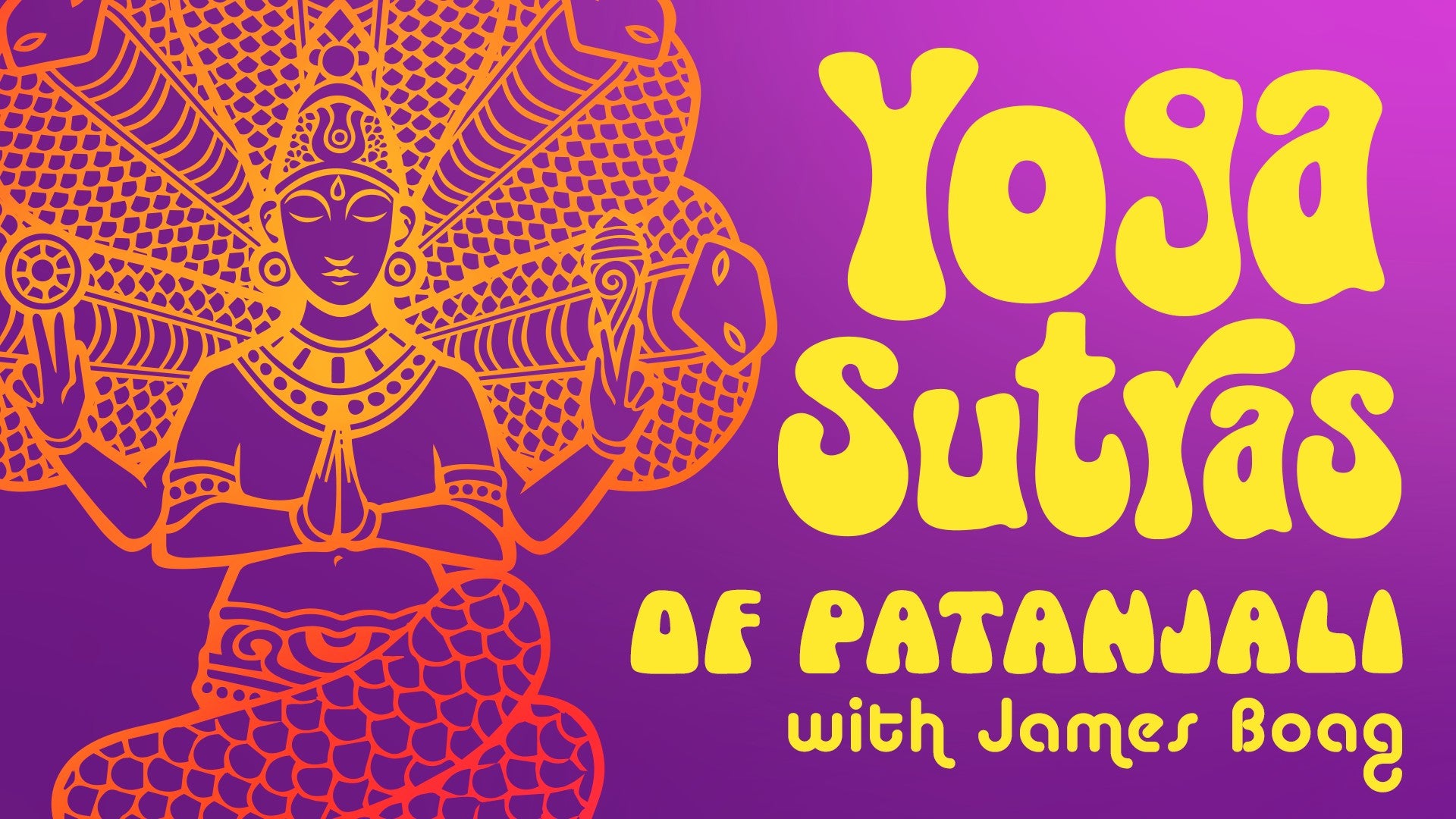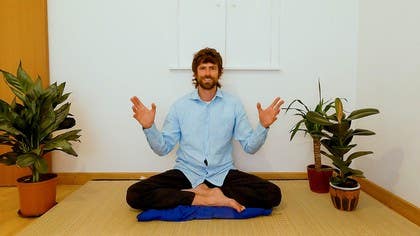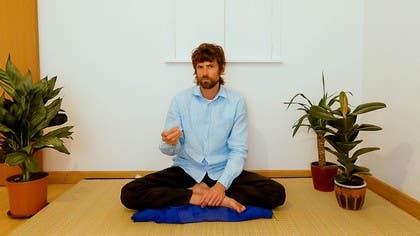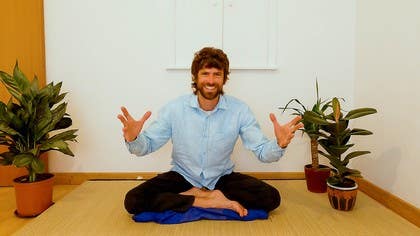Description
About This Video
Transcript
Read Full Transcript
So, what this Sutra says is that, so we've heard already that the seen world, the seen world, exists for the sake of the seer. So then there might come a question, well, if then the seer is recognized, remembered and fully established in itself, what then happens to the seen if it has, as it were, served its purpose? And so it potentially tells us á¹?rÄ«tÄ쳌tam pratÄ« nÄ쳌á¹£tam Ä쳌pi Ä쳌á¹?ashtam tÄ쳌raá¹?mÄ« sadar nÄ쳌dvÄ쳌t. So what he says is, it will indeed dissolve, it will be made zero for the one who is fully realized. But for Ä쳌á¹?yÄ쳌, for other people, it will not be nÄ쳌á¹£á¹a, it will not be destroyed, it will not be dissolved. Sadar nÄ쳌dvÄ쳌t, on account of its commonality, on account of it being based on something that is experienced by many people, something that is on the common ground of existence. So what potential is basically saying here, the known world, as it were, is destroyed, obliterated, dissolved for the one who is fully realized. When we are fully realized, then the world has served its purpose. But for the others, for everybody else, the world will continue to be experienced, owing to the fact that this is based on those, sadar nÄ쳌 means those things that it has in common. So earlier in the chapter, we got this map of sÄ쳌á¹?kÄ«, we got this model of how consciousness overflowed, emitted nature, and then nature became manifest. That manifest existence, the potential is making it very clear, this is the real field for the process of yoga, for the game of life. And this is an important point. In yoga, the world is not to be dismissed as an illusion. The world is real. The world is the field of bondage, but it is also the field of liberation. And so the instruction in yoga is, you're on the field, get in the game. This is the opportunity, this life. So of course, from a certain perspective, we can say, well, all these comings and goings are not as real as the underlying pure consciousness of zero state, which underlies it all. But what is all of this manifest reality constituted of? Where did it come from? So in the yogic vision of reality and existence and life and the universe and everything, the universe and everything and nature and life, it came out of consciousness. So it is consciousness. It's constituted of the very stuff of consciousness. And so that means from the yogic perspective, everything is the means to help us recognize our essence. And from another perspective, we might say, everything is divine. This was emphasized in chapter one, when we practice recognizing the divinity of everything, this is going to be one of the things that can really help us come to recognize the underlying essence of everything. And this is one of the beautiful teachings in the Indian vision of reality, that existence is divine. It has been given to us. Where was I when this life was being made? It's all come to us. Now human beings, sometimes we can get a little bit carried away with our understanding, things we've managed to grasp or get a little bit of an understanding of. But there's always so much more that we're not able to apprehend. And sometimes the things that we can be so confident about being real or true in one generation, perhaps, or at one stage of our life in a later stage of life, or as human beings find out more things as our means of perception expand, then the things we used to be so sure about, we realize they're no longer true. They're no longer telling us the whole picture that we're now aware of.
But nonetheless, everything that we're experiencing is helping us, to some degree, start to understand ourselves and ultimate reality a little bit more. So it's the idea that even if we're seeing something in a partial way, we're only able to see it at all because there is at least some consciousness there. So everything is the means, everything is the opportunity to learn. So throughout this chapter, there's great emphasis on apprenticeship, on studentship, on always being the student, on always remembering that life is an opportunity to learn, to grow, to realize more, to recognize more. So yes, ultimately, there is the possibility to transcend, go beyond this experience of nature, the things that come and go, and reside in that state of ultimate wholeness. But along the way, and for everybody else who doesn't get to that state, this field of existence is real. And this is the real opportunity in which to come to that recognition. So going back to the previous story I told about the jigsaw, and I mentioned also Shiva and Yogishwara. Now when Shiva is depicted as Yogishwara, he's there sitting in a meditative posture, and often he's garlanded with the king cobra, maybe has some ash on his body, maybe has a little bit of elephant hide around his midsection. And on his forehead, he will have as one of his ornaments, the crescent moon. Now there are many, many layers of beautiful practical symbolism here, but one thing we can interpret this, or one way this is interpreted in the Yog tradition, is this sliver of the crescent moon on Shiva's forehead is a representation of all of the 118 worlds of existence, all of the universe or multiverse, all of reality, all of manifestation is like the sliver of the crescent moon on the forehead of Shiva, and the whole figure represents the body of consciousness within which all of manifest existence occurs, arises, is experienced. So sometimes people say things like, oh, the world is an illusion. Oh, it doesn't really matter. This is not the view of the yogic position. There are some schools of philosophy where there is that more emphasis on really coming to an understanding of that deeper layer of existence at the intellectual level. But in yoga, it's always about the whole picture, the integrated experience, the embodied lived experience. And in yoga, there is no conflict or discord between living well, living skillfully here on earth as a human being in society on this planet and moving towards ultimate realisation. Really, there's the idea that the two of them go hand in hand. This is very much an intrinsic part of the yoga tradition. Now one thing I find interesting in this sutra is it says that the scene dissolves for the one who realises the essence. It doesn't dissolve for the others. Now, just recently, I was listening to an interview with a beautiful man called Satish Kumar, who I had the great pleasure of meeting and attending a one day programme he gave actually here in my hometown. I was very surprised. I was studying in India and I come home to visit and I go to the local that shop, I buy most of my groceries and I see on the counter Satish Kumar is giving a talk in the local like the town hall. Whoa, whoa, I'm definitely going to see this Satish Kumar aged 18. He was brought up in a giant family in India. And age 18, he's with his friend in the coffee shop or the tea shop. And they are discussing the horrors of the Cold War and the nuclear arms race and all of this. And the two friends decide enough talking about world peace, we have to do something. And so Satish Kumar and his friend decided that they would undertake a peace pilgrimage. And they walked from India to the then capitals of the nuclear world. So they walked to Moscow and Paris and London and Washington DC. They got on a boat at some point, but they undertook the journey mostly on foot with no money.
They went to their teacher and they said, we had this idea. And he said, this is an excellent idea. Pilgrimage is a very significant part of their tradition. And the teacher said, but you must, you must go with no money, you know that. And they said, at this time, there was a lot of conflict between India and Pakistan. And Pakistan was the first country they would have to go through and says, but Pakistan is the first country. He says, yes, but it's fantastic that that is the first country because there that means that right from the beginning of this journey, you will really learn what it means to walk a peace pilgrimage. So you have all my blessings. This is a wonderful idea. And they went off. And this story is told in Satish Kumar's autobiography. He's a man of such deep inspiration because he has really walked his talk and he's gained so much amazing experiences now in his 80s. But I was listening to an interview with him by the by Russell Brand and Satish Kumar said this most beautiful thing. And Russell Brand was saying, you know, but if we want to change the world, there are these entities, these powerful bodies who are benefiting a lot from the status quo, which isn't really good for long term planetary health or long term human health. And whenever people rise up to try to oppose them, they kind of clump down more and more. And Satish Kumar said this most beautiful thing. And, you know, he said, well, he said many, many beautiful things in this interview. And, you know, he was 84 at the time of the interview. And he said, I'm an activist, I keep acting. He said, to be an activist, you have to be an optimist, because you have to believe you have to keep you have to keep doing. He says like he was very influenced by Gandhi says be the change you want to see in the world. So this is what we need to do is to make a spiritual solution. We don't fight against the problem. We have to be like sugar. You put sugar in water and the bitter or you put sugar in a bitter soup, and the sugar dissolves. And that which was bitter is transformed to something that is so sweet. He says this is what you have to do. If you want to bring about a spiritual evolution in the world, you need to be like the sugar that is irresistibly sweet and alluring and captivates the other people. So be the change, be the invitation. And then the resistance to this wiser, more sustainable way will dissolve when people all around can recognize and relish the sweetness, the richness, the beauty, the grace of this different way. So here it says the seen world will dissolve for the one who is realized, but how are we going to get realized? Not by denying the world, not by complaining about the world, not by desecrating the world, not by denying the world, but rather by participating in it skillfully. Pristin the Bhagavad Gita says, what is yoga? It is samatva, it is evenness and it is karma su kauslam, it is skillfulness in the things that we do. So by walking on this planet with grace, with gratitude, by leaving things better than we found them. This is what in the Indian system, what is the purpose of life? What is the duty of a human being to leave the existence better than we found it? And there's the idea that in order to become realized, if we live our life like that, if we have that constant studentship, that constant willingness to explore, then step by patient step, we can live that little bit more skillfully and we can play our little part in making this world a more beautiful place and leaving it in better shape for our descendants than we encountered when we emerged into this existence. And the idea that if we do that, that is not going to derail us from becoming realized, rather that same effort, that intent, that steady, diligent apprenticeship to living in a way that is sweet, that is rich, that is nourishing, that nourishes the environment, that nourishes our relationships, that nourishes the wellbeing of the whole, the depth of presence, the gratitude, the grace that this necessitates is going to be almost like the turbo charge for any type of spiritual quest. So, living skillfully in the world and becoming realized from the yogic perspective, these things are not in conflict at all, rather these are the things, these are the two legs that walk together step by patient step towards that zero state of completion and wholeness and fulfilment.
Yoga Sutras of Patanjali: Life is the Guru
Comments

You need to be a subscriber to post a comment.
Please Log In or Create an Account to start your free trial.








